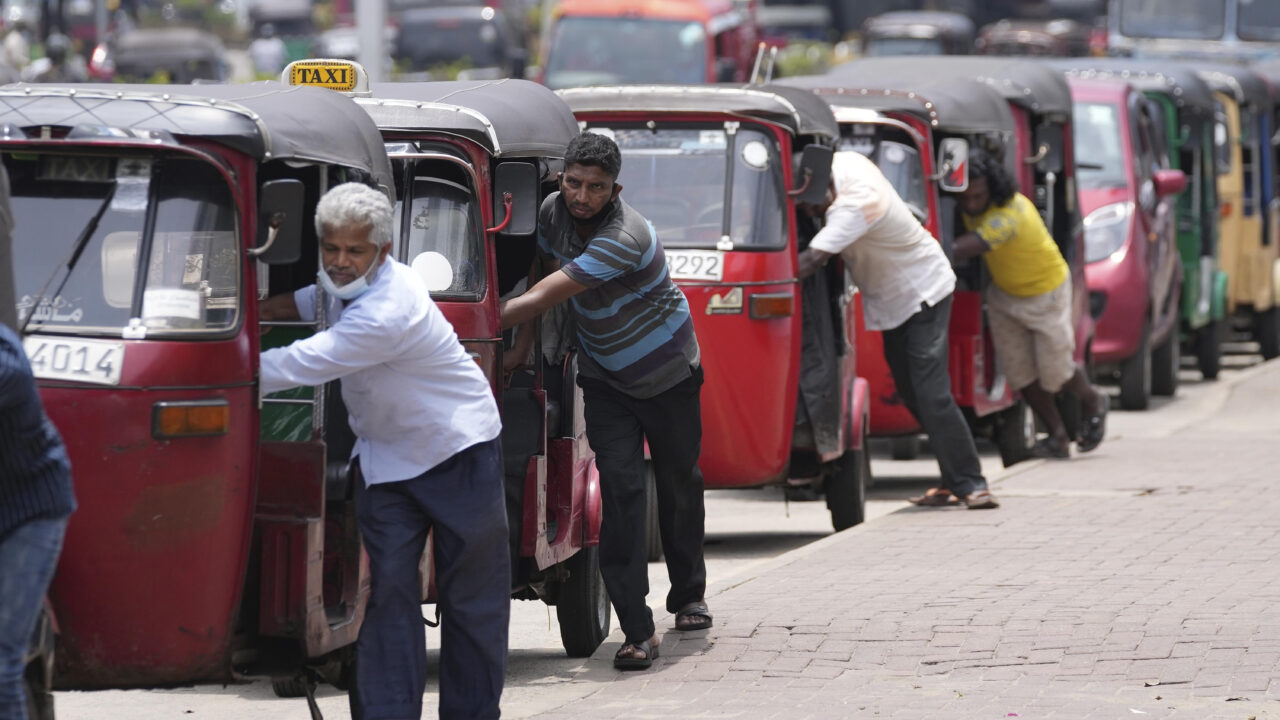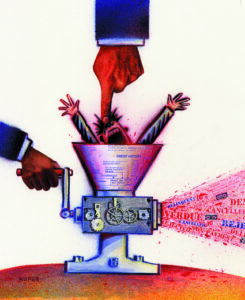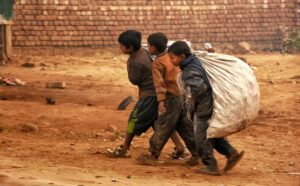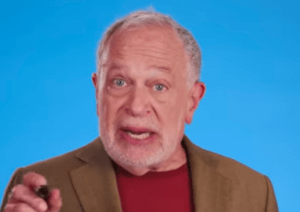Sri Lanka and the Great Lie of IMF Dependency
Decades of looking to the IMF for salvation has yielded only crises. Auto rickshaw drivers line up to buy gas near a fuel station in Colombo, Sri Lanka, Wednesday, April 13, 2022. Photo: Eranga Jayawardena / AP.
Auto rickshaw drivers line up to buy gas near a fuel station in Colombo, Sri Lanka, Wednesday, April 13, 2022. Photo: Eranga Jayawardena / AP.
Sri Lanka has been subject to a great lie: the IMF solution! For close to a year now, the country has been implementing the International Monetary Fund’s recommendations with complete obedience. The sudden devaluation of the Sri Lankan rupee, a drastic increase in interest rates, the withdrawal of fuel subsidies and severe cuts to state expenditure all amount to harsh austerity measures. The consequence is economic devastation as the country sinks into a depression. Millions now suffer dwindling incomes, tremendous increases in the cost of living, food insecurity and even starvation.
Yet the much-touted IMF funds presented as a way to salvation, a meagre USD 2.9 billion over four years under the proposed agreement, have proved elusive. Compare this amount to Sri Lanka’s foreign earnings for last year, which added up to USD 18 billion. The IMF insists that Sri Lanka first convince a range of creditors to commit to restructuring its defaulted external debt before the organisation’s Executive Board will release the funds. But Sri Lanka’s economy is in free fall. Its GDP contracted by roughly a tenth last year and is on the path to continued contraction this year. Under these circumstances, the IMF agreement and its paltry funds may as well go into the dustbin.
Some of us have seen this crisis coming for a long time. A few months after the end of the civil war in May 2009, Sri Lanka obtained an IMF Stand-By Arrangement of USD 2.6 billion. This gave the green light to a considerable inflow of speculative foreign capital, in addition to commercial borrowings at extremely high interest rates in the form of International Sovereign Bonds (ISBs). At that point, the warning bells began ringing for critical analysts who could see the consequences. But back-slapping and self-congratulation among Sri Lanka’s elites continued amid a boom in economic growth built on a dubious basis, including speculative investment in urban beautification and needlessly large infrastructure projects. This debt-driven boom soon petered out.
Sri Lanka then faced balance-of-payments problems, which pushed it towards an IMF Extended Fund Facility of USD 1.5 billion in June 2016. Some of us sounded the alarm again as the government at the time, led by Ranil Wickremesinghe, pursued another IMF-led solution. But, again, our critique fell on deaf ears. Worryingly, the following month, with the IMF’s approval, Sri Lanka went ahead and floated another USD 1.5 billion in ISBs. Indeed, the latest IMF agreement—the 16th deal between Sri Lanka and the organization over the decades—offered nothing new. Rather, it promoted Sri Lanka’s continued liberalization of trade and capital accounts, dating back to the opening of the economy in 1978. The crisis tendencies in the Sri Lankan economy were ramified through adherence to IMF packages.
Historical memory is short in Sri Lanka, particularly among the elite. The crisis accelerated with the onset of the Covid-19 pandemic three years ago. Again, we warned of the imminent dangers of an unsustainable balance of payments and the need to drastically reassess and reprioritize imports for the purpose of maintaining foreign reserves, given decreasing streams of foreign earnings. That would have meant restricting the import of luxury consumer goods while using the available foreign exchange for essential supplies and intermediate goods necessary to boost domestic production. The arrogant Rajapaksa regime then in power nevertheless persisted in the blind hope that fortunate times were just around the corner. It argued that tourism, for example, would soon pick up. Meanwhile, the opposition and neoliberal think-tanks proposed yet another IMF agreement as the magic bullet. Worse, they even started calling for an early default on Sri Lanka’s external debt. Their convoluted logic was that once the country defaulted, it would have to surrender to the IMF and all its conditionalities, such as austerity and fiscal consolidation. There could be no way forward other than with the IMF.
That is exactly what the government led by Gotabaya Rajapaksa did in April 2022. It prematurely defaulted on its external debt while the finance minister went on pilgrimage to Washington DC to the annual meetings of the IMF and the World Bank. The default was premature because only USD 78 million in debt-servicing was due that month, while the next large ISB repayment, of USD 1 billion, was due in July 2022. Only in Sri Lanka could the elite celebrate when the country defaulted on its sovereign debt for the first time in its history. They were confident that Sri Lanka would get bridge financing from donors, an IMF agreement with additional funds in three months, and a rapid process of debt restructuring. Ten months later, the outcome of these expectations remains a shameful zero. There is no more bridge financing. No IMF funds. And an agreement on debt restructuring appears uncertain at best.
Given all the above, Sri Lanka is a case in point of consistently insipid economic policymaking. It is also a study in how the myth of an IMF quick-fix can paralyze a country, putting on hold policies and relief measures urgently needed to help a citizenry drowning in economic depression. As the country awakes to the great lie of an IMF solution, it is forced to go back to the drawing board – not just to deal with the social devastation and political backlash that the IMF agreement is bound to generate, but also because the global order that provided its reference points is unravelling.
How can Sri Lanka’s debt be made sustainable by further exposing the country to these chilling headwinds?
Sri Lanka’s long engagement with the IMF and the broader neoliberal policy consensus—austerity, privatisation, and the liberalisation of trade and capital markets—has been an utter and complete failure. Nevertheless, for the IMF and Sri Lanka’s establishment, resolution of the crisis appears to call for the introduction of austerity measures like the ones applied to many other countries that have experienced sovereign default, along with restructuring of defaulted debt. The idea is that Sri Lanka’s problems are rooted in a fundamental mismatch between its macroeconomic indicators and the debt it has accumulated.
This framework is being applied, however, in the context of a world order that is fast breaking down because of the contradictions of neoliberal globalization. Over the last decades, the push for free trade, unfettered global financial flows and the privatization of essential services has continued to expose countries to the crisis-ridden dynamics of global capitalism. But everything appears to be coming to a head, epitomized in many ways by the case of Sri Lanka. As major publications such as the Financial Times have noted, although exogenous shocks such as the Covid-19 pandemic and war in Ukraine have played a role, these have interacted with underlying trends in the global economy. This includes extreme wealth inequality and an unsustainable model of growth driven by financialization, exposed most vividly by the global financial crisis of 2008.
In the aftermath of the 2008 crisis, however, and coincident with the end of the civil war, Sri Lanka was one of a series of emerging market “success stories” celebrated by boosters of neoliberalism. Now that the country’s shaky financial structure has been exposed, establishment commentators around the world are instead using Sri Lanka as an example of crony capitalism and corruption. Supposedly, such bad actors can only be routed by further imposing the rationality of the market on public institutions. Whereas the big banks in the United States responsible for the 2008 crisis obtained bailouts from the state because they were “too big to fail,” Sri Lanka is apparently small enough that the rules of moral hazard once again apply. The failed logic of the neoliberal development model— including the reliance on external-oriented policies, from tourism to foreign commercial borrowings—here justifies further entrenching it through austerity. Because of the country’s severe economic crisis, however, such a remedy means that people suffer and possibly even perish from what the sociologist Karl Polanyi called “social exposure.” Child malnutrition is skyrocketing and food insecurity is becoming pervasive—recent estimates from the UN’s Food and Agriculture Organization indicate that roughly a fourth of Sri Lanka’s population is food insecure. Even this extreme suffering is unlikely to dislodge the elite consensus about an IMF solution. But the disruptive political and social consequences, and resulting waves of agitation, will continue.
Moreover, Sri Lanka’s crisis is occurring at the conjuncture of major global developments. Global growth, especially in trade, is likely to continue slowing in the face of a complex set of challenges, from geopolitical polarisation to the impact of climate change. In this scenario, how can Sri Lanka’s debt be made sustainable by further exposing the country to these chilling headwinds? The central plank of the IMF solution—that Sri Lanka achieve a primary surplus by 2025—stands in direct contradiction to the lack of the public investment needed to cope with these shocks. Conventional debt-sustainability analysis is predicated on the belief that by engaging in macroeconomic reforms such as fiscal consolidation, defaulting countries can regain their financial footing by having the surplus funds to both repay old loans and service new ones. However, in the case of Sri Lanka, which is already undergoing an economic depression, national private investment is withdrawing, and speculative capital is fleeing the country. The idea that foreign investors will step in to fill the breach flies in the face of Sri Lanka’s long experience with similar false projections.
The idea that Sri Lanka can achieve higher stages of development by pursuing the same growth path rooted in dependency on the external sector is a non-starter.
Sri Lanka did not always have an unshakeable belief in the benefits of subordination to global capital. After the 1956 general election, there was a clear push to challenge the colonial relations in which the country’s comprador elites were embedded. Through a new balance of class forces, there was much greater emphasis on industrialization focussed on import substitution, to try and diversify the economy away from plantation exports. Sri Lanka undertook major investments in critical industries, such as those producing intermediate and capital goods, including with support from socialist countries. But even these efforts were constrained by over-reliance on a narrow political base among the urban working class and a lack of rural mobilization. By the time of the global economic downturn of the 1970s, the radical wing of the left-leaning United Front was led by NM Perera, the finance minister. It made a belated attempt to prioritize self-sufficiency in food production and address the immediate concerns of working-class people, especially given rising global prices for essential goods. But these efforts failed due to internal contradictions within the ruling coalition led by the bourgeois Sri Lanka Freedom Party, the consolidation of Sinhala Buddhist nationalism and state repression, external pressure from the West and the rising frustration of the electorate.
The subsequent regime, led by JR Jayewardene, introduced the open-economy reforms in 1978, which meant a strong emphasis on liberalization. Sri Lanka’s engagement with the outside world reverted to subordination to powerful institutions that represented the interests of global capital. The IMF and the World Bank provided the necessary justification in terms of access to external finance. Meanwhile, the Jayewardene regime suppressed organized labour, including by crushing the general strike of 1980. In this and other ways, the regime prepared a more conducive terrain for extraction and exploitation. The beginning of the civil war between the government and Tamil separatists in the country’s north and east in 1983 put some constraints on this approach, as the state continued to rely on mobilization in the south. But the overall trajectory was epitomized by the collapse of any real alternative to neoliberal policies. The consensus was that for Sri Lanka to develop it would have to import its economic vision from outside—a vision clearly shaped by the interests of global capital. The processes of financialization and debt-driven growth accelerated with the end of the civil war.
This strategy has failed to bear fruit in terms of real improvements in working people’s livelihoods. It has also triggered the current crisis. Nevertheless, in the many years since Sri Lanka embarked on liberalisztion, justification for foreign commercial borrowing has been rooted in the enduring assumption that the country need only “unlock its growth potential”. A range of services and industries meant to earn foreign exchange have been bandied as model opportunities. After the early days of the open economy, it became clear that a developed garment industry was not a precursor to moving up the “global value chain.” This was especially true in the absence of a clear, concerted intervention by the state in the form of industrial policy. Global institutions and policy-makers then pivoted to celebrating the rise of the service economy, including the boom in tourism. Sri Lanka continued to depend, however, on a hidden economy of remittances from migrant workers abroad, which is also now under strain.
The idea that Sri Lanka can achieve higher stages of development by pursuing the same growth path rooted in dependency on the external sector is a non-starter. The neoliberal development model has collapsed. The Sri Lankan establishment has practically admitted as much by seeking lower-income status for the country to obtain more concessional financing from international donors and aid agencies. At the same time, the government, led by Ranil Wickremesinghe, is eager to celebrate the return of tourists after a long absence caused by the Covid-19 pandemic and the Easter Sunday terror attacks in 2019. But the reality is that tourism will not be enough to revive Sri Lanka’s growth during a period of painful austerity. The same goes for any number of hare-brained ideas that may now be touted by the country’s economic establishment in the absence of serious thinking about an alternative development model.
Sri Lanka’s lop-sided economic structure, with a bloated import bill and unrestrained financial speculation, now faces a reckoning. The years of conspicuous consumption through imports from abroad are over. The question is, how can investment be channelled into those sectors necessary for the country to achieve self-sufficiency in the goods and services ordinary people need for survival? This perspective is a far cry from the IMF solution, which presupposes Sri Lanka’s continued subordination to a global economic structure that has clearly failed. Taking up the question of an alternative means returning to issues that had supposedly been bypassed with the triumph of neoliberal globalization. It requires revisiting the many “reforms”—from the push for trade and capital-account liberalization to the promotion of foreign direct investment and privatization—that it has entailed.
Sri Lanka’s domestic debt is also a critical part of the equation for overcoming the current economic depression
Under these circumstances, the idea of self-sufficiency offers a crucial response to the rapidly changing, uncertain global order. This churn may provide an opportunity for foresighted actors within Sri Lanka to demand a fundamental re-conceptualization of how external engagement fits into the country’s development model. If it is imperative to revive the country’s domestic food production, for example, how would this flow into a broader rethinking of the composition of intermediate imports needed for production? What type of external financing would be necessary to develop the domestic food system?
Sri Lanka’s domestic debt is also a critical part of the equation for overcoming the current economic depression. That includes the need for counter-cyclical spending, as opposed to pro-cyclical policies of fiscal consolidation. But external development finance would also continue to play a role. The key question is whether such borrowings are integrated into a process of planning, so that an alternative development vision takes precedence over the mainstream understanding of market-steered investment that has long shaped countries such as Sri Lanka. The country must push back against global capital geared towards the sole end of financial extraction. Indeed, the lion’s share of foreign direct investment into Sri Lanka went into speculative investment in real estate rather than ventures that increased local industrial production. Development financing should be reconfigured as part of a bottom-to-top restructuring of the economy, along with changes in trade policy away from excessive imports. That is necessary both to repay the current debt—with deep haircuts for creditors, if not debt cancellations—and as a means to develop Sri Lanka in the long run.
This alternative goes back to similar points made by development economists such as Ha-Joon Chang and Abhijit Sen, who were early critics of the Washington Consensus. Such critical economists recognized the flaws in the previous model of import substitution, but they framed it as an ongoing concern of the balance of social and class forces required to ensure that capital, as it grows, is also disciplined to invest in critical sectors. In Sri Lanka’s case, that process of disciplining capital must now include prioritizing imports of essential and intermediate goods necessary for production. It also requires revamping the defunct public-distribution system to ensure food security and prevent outright starvation. As the economy stabilizes, further measures must also include redistribution and investment through a wealth tax on existing property and assets.
Sri Lanka has to have stronger debates about its development vision, including a rethink on relations between its rural and urban arenas. There must be greater room for rural industries rooted in the livelihoods and reproductive needs of ordinary people. This is a far cry from the elites’ vision of the economy, which has repeatedly driven Sri Lanka into financial difficulties. There is now tremendous anger in the country because of the devastating fall in living standards. This discontent, in addition to the unravelling global order, may finally trigger a break with liberalization.
For the IMF, of course, a program rooted in self-sufficiency with wealth taxes and reinvigorated public investment will be a step too far. It is entrenched in its own institutional processes, despite the organization’s fuzzy rhetoric around its newfound supposed awareness of the social implications of austerity-driven bailout agreements. Nevertheless, Sri Lanka’s crisis may offer a turning point for those global and domestic coalitions that are aiming to push back against renewed subordination to global financial capital. That means rethinking a number of trends that have long coalesced under the banner of economic liberalization. After decades of repeated mistakes and failures, with consequences for the people on an unprecedented scale, will the establishment at last be forced to reconsider Sri Lanka’s development model?
This article originally appeared at Himal Southasian (www.himalmag.com).
Your support matters…Independent journalism is under threat and overshadowed by heavily funded mainstream media.
You can help level the playing field. Become a member.
Your tax-deductible contribution keeps us digging beneath the headlines to give you thought-provoking, investigative reporting and analysis that unearths what's really happening- without compromise.
Give today to support our courageous, independent journalists.









You need to be a supporter to comment.
There are currently no responses to this article.
Be the first to respond.